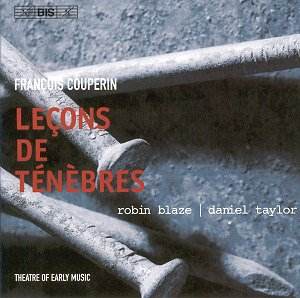The
service of Tenebrae was originally celebrated at Matins during
Holy Week; this took place at around 3.00
a.m., hence the name tenebrae (darkness).
The service was divided into three Nocturns, each of which consisted
of three psalms, three anthems and three lessons followed by
responses. The lessons are taken from the Lamentations of Jeremiah.
In
late 17th century France,
it became popular for composers to provide musical settings
of these lessons. The popularity of the service caused it to
be moved to the afternoon of the previous day and the service
was particularly observed in convents. The first musical settings
come from such composers are Bouzignac (before 1643) and Michel
Lambert (c. 1660). Marc-Antoine Charpentier composed about forty
settings in the period 1670 to 1704 and François Couperin composed
his settings in the period 1713-1717; these three surviving
Lessons are all that we have of Couperin’s output. These French
composers developed a particular genre of these settings, using
just a few solo voices and continuo, setting the Hebrew letters,
which prefix the verses, as long melismas and ending each lesson
with the words Jerusalem, convertere ad Dominum Deum tuum
(Jerusalem, turn back to the Lord your God). The pieces were
written for use by soprano voices in a convent; some convents
employed professional sopranos for these services, utilising
female opera singers who were otherwise unemployed as theatres
were closed in Holy Week.
Couperin’s
settings have been recorded by a number of groups including
Christoph Rousset’s Les Talents Lyriques and William Christie
and Les Arts Florissants. Performances increasingly reflect
our more developed knowledge of the performance practice for
French music of this period, thanks in no small way to Christie
and his group. Christie’s superb recording uses sopranos Patricia
Petibon and Sophie Daneman, who sing with great purity and use
French pronunciation for the Latin.
But
there is also another recorded tradition, a more English one.
These pieces were recorded in the 1960s by Alfred Deller. Deller
sings the pieces with his customary acuity and superb control
of tone, enunciating the text using standard Latinate pronunciation.
It
is perhaps Deller’s example, rather than William Christie’s,
that Robin Blaze and Daniel Taylor are following on their new
recording with Taylor’s group Theatre of Early Music. Like Deller, they use standard Latinate
pronunciation and their performance shows all of the shapely
care that we would expect from these fine singers, without ever
utilising any of the French Baroque mannerisms familiar from
other recent recordings.
Blaze
and Taylor have slightly differing voices. Blaze’s
voice has a rather English edge to it, something I rather like.
Taylor’s has something of the more continental
softer edges, but both seem to have a commonality of technique
and purpose in these pieces. Their voices blend beautifully,
though always remaining distinct. Each takes one of the solo
Lessons, Taylor takes the upper part in the Lesson for two voices
and Blaze takes the upper part in the Magnificat (also for two
voices).
The
result is some music-making of a high order. Both singers take
care of the long lines of the music, but give shape to individual
moments within phrases. There is just the hint of mannerism
in the way that, in the Third Lesson (for two voices), they
almost croon the melismatic settings of the Hebrew letters.
I found Blaze’s habit of developing vibrato on the longer notes
a little disturbing; I am unsure whether this is deliberate
or simply a vocal mannerism. Others, who are less affected by
vibrato, will not be so troubled by this.
It
is unfortunate that Taylor’s
new group is called Theatre of Early Music, because dramatically
theatrical is exactly what this performance is not. It is very
English in the feel of its cool, well modulated lines. Many
people will be happy with this music making of a high order
and I will be returning to the disc. But I have a soft spot
for the soprano versions of these pieces, and a preference for
a performance more inflected by French Baroque mannerisms.
More
seriously, I feel that the singer’s vocal lines could be invested
with more intensity and emotion without damaging the sense of
line itself. You only have to listen to Deller’s spine-tingling
way with this music
Besides
the Lessons, Blaze and Taylor
give us a fine performance of the Magnificat, which dates from
before 1702. A showier, less inward work than the Lessons; Blaze
and Taylor respond well to its exuberance.
Blaze
and Taylor are ably supported by gamba player
Jonathan Manson and organist Lawrence Cummings. Having whetted
our appetite with this fine recording of the well known Leçons
de Ténèbres I hope that the group are able to go on to delight
us with some of the lesser known items in this repertoire.
Robert
Hugill

![]() Theatre of Early Music: Robin Blaze (counter-tenor); Daniel Taylor (counter-tenor);
Jonathan Manson (viola da gamba); Laurence Cummings (organ)
Theatre of Early Music: Robin Blaze (counter-tenor); Daniel Taylor (counter-tenor);
Jonathan Manson (viola da gamba); Laurence Cummings (organ)![]() BIS
CD-1346 [59.20]
BIS
CD-1346 [59.20]





